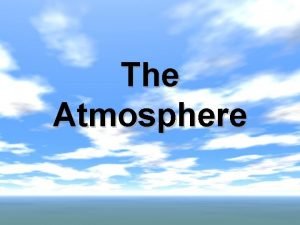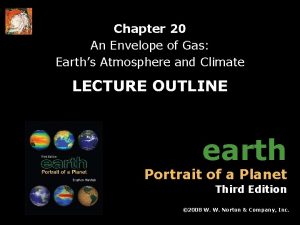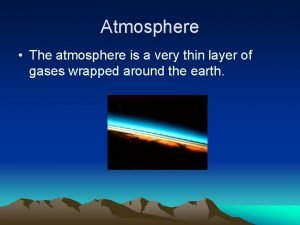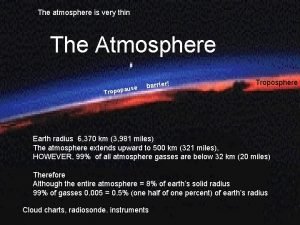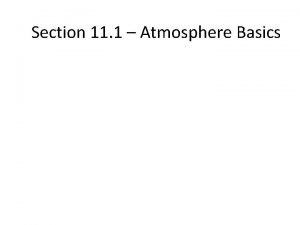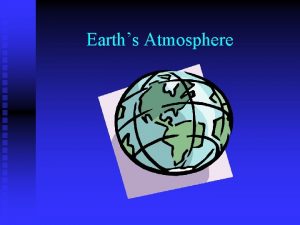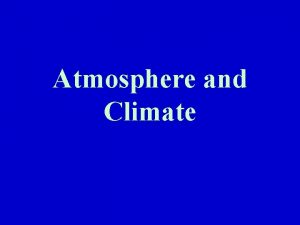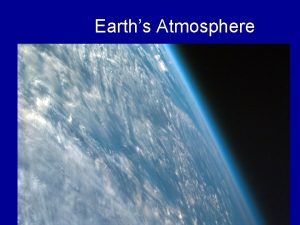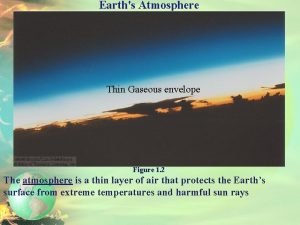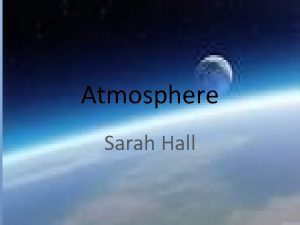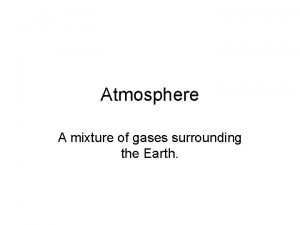The Atmosphere thin envelope of lifesustaining gases surrounding












- Slides: 12

The Atmosphere

thin envelope of life-sustaining gases surrounding the earth u divided into five spherical layers u

Troposphere u innermost layer extending about 17 km above sea level u contains about 75% of the mass of earth’s air u weather occurs here u 78% nitrogen / 21% oxygen / 1% argon / 0. 036% carbon dioxide

The Troposphere u average pressure exerted by gases in the atmosphere decreases with altitude because average density (mass of gases per unit of vol. ) decreases with altitude u tropopause: top zone of the troposphere where temperature declines with altitude but then abruptly begins to rise

Stratosphere u atmosphere’s 2 nd layer extending from 17 -48 km above earth’s surface u contains less matter than the troposphere but has similar composition u calm air, little mixing - good for flying planes

OZONE u ozone: “global sunscreen” keeps about 99% of UV radiation from reaching earth u allows humans and other life to exist on land u helps protect humans from sunburn, cancer, cataracts, damage to immune system

OZONE u prevents oxygen in the troposphere from being converted to ozone, a harmful air pollutant which causes smog and damage to plants u stratopause: top zone of the stratosphere and the beginning of the mesosphere where temperature reverses after rising with altitude

Mesophere the air masses are relatively mixed together and the temperature decreases with altitude Atmospheric temperatures reach the lowest average value of around 90°C in the mesosphere. This is also the layer in which a lot of meteors burn up while entering the Earth's atmosphere. u The mesosphere extends from about 50 kilometers to an altitude of about 90 kilometers u

Thermosphere u layer of the atmosphere which is first exposed to the Sun's radiation. The air is so thin that a small increase in energy can cause a large increase in temperature. u The temperature in thermosphere is very dependent on solar activity. When the Sun is active, temperatures can reach up to 1, 500°C or higher!

Thermosphere u u Because of the thin air in thermosphere, scientists can't measure the temperature directly. They measure the density of the air by how much drag it puts on satellites and then use the density to find the temperature. The thermosphere also includes the region of the Earth's atmosphere called the ionosphere. The ionosphere is the region of the atmosphere that is filled with charged particles. Elevated temperatures can sometimes cause a molecule to become ionized, therefore, the ionosphere and thermosphere can overlap.

Exosphere u The region where atoms and molecules escape into space is referred to as the exosphere. This is the true upper limit of the Earth's atmosphere

 A thin layer of gases surrounding earth
A thin layer of gases surrounding earth The thin envelope of gases
The thin envelope of gases Very thin layer
Very thin layer It has a very thin atmosphere
It has a very thin atmosphere The atmosphere is a mixture of ___________.
The atmosphere is a mixture of ___________. Gases on earth's atmosphere
Gases on earth's atmosphere Chapter 5 skeletal system figure 5-13
Chapter 5 skeletal system figure 5-13 Where is ancient greece located today
Where is ancient greece located today Double layered membrane that covers the lungs
Double layered membrane that covers the lungs Surrounding net
Surrounding net Krono original
Krono original Hollow portions of bones surrounding the nasal cavity
Hollow portions of bones surrounding the nasal cavity Social issues in information technology
Social issues in information technology
